Menu
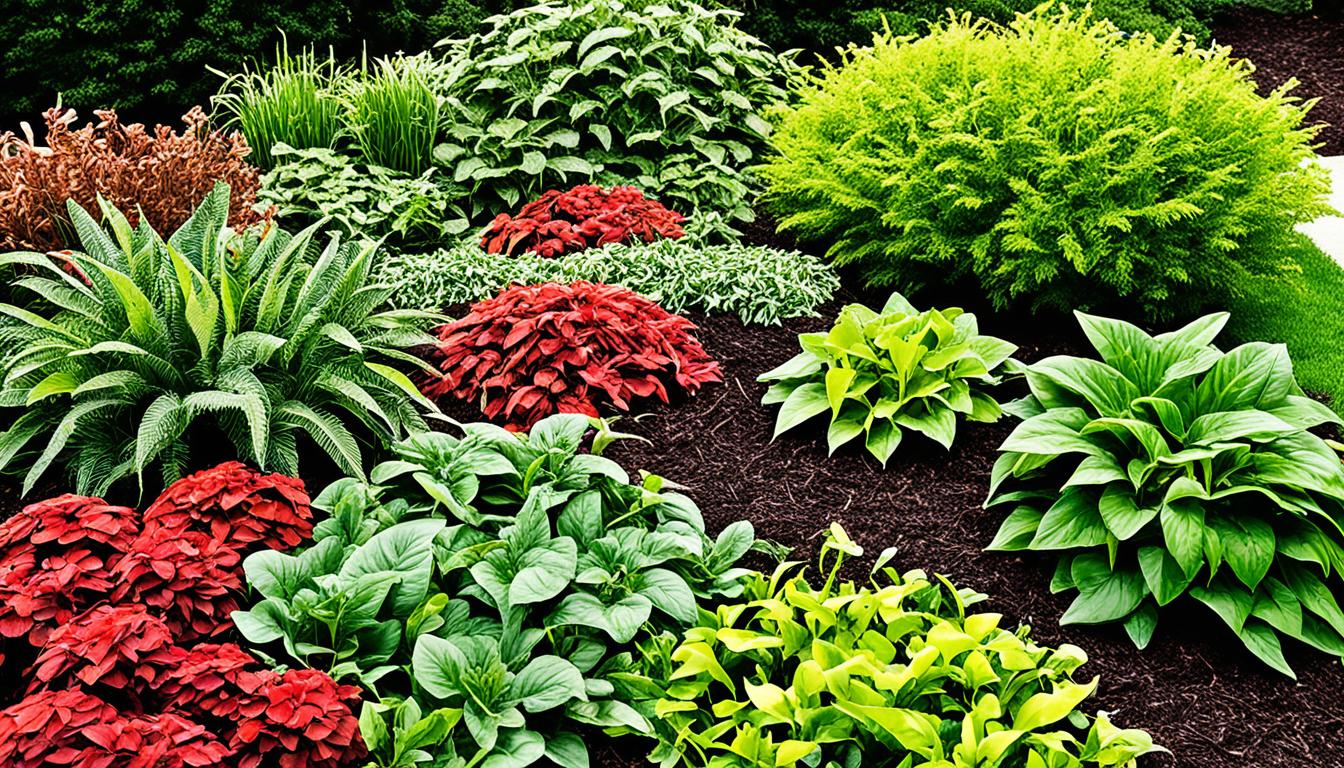
Have you heard that spreading 3-4 inches of hay mulch can cut down on weed seedlings? This fact highlights how organic mulching benefits our gardens. It makes our outdoors look great and improves the soil. This keeps everything in a good, natural balance.
Using organic mulch is key to smart gardening. It means using things like shredded leaves and grass to help the soil. These materials create a bridge between what we do in our gardens and nature. When the mulch breaks down, it puts important nutrients back into the ground. These help the world below us to thrive. By using organic mulch, we show we care about the Earth and want a lot of different plants and animals in our gardens.
Organic mulching is now key for green gardens. The introduction to organic mulching shows its big role in making soil better, saving water, and helping the planet.
To get mulching, first, we must know the basics. Mulching is about covering the ground with things like twigs or pebbles. This keeps the soil moist, its temperature even, and stops weeds.
Hay mulch, if it’s 3–4 inches thick, can stop weeds from growing. This is especially true for weeds with small seeds. Grass hay is great for this. It has less nitrogen but more potassium. It can keep soil healthy and weed-free for a long time.
Looking at mulching history shows changes from old to new methods. Long ago, people used things like straw to help the soil. They noticed it made the soil better and kept moisture in. So, using organic materials for mulching got popular.
Today, using grass hay and more is common. But sometimes, chemicals in mulch cause big problems for crops. Crops like tomatoes and cucurbits can be hurt.
Now, we mulch in eco-friendly ways. Using things like straw and leaves puts good stuff back in the soil. It also stops the soil from washing away. This helps during both very wet times and dry seasons. It’s great for plants.
Using organic mulch helps plants in many ways. It improves soil, keeps the right temperature, and stops weeds from growing. When the mulch breaks down, it makes the soil healthier. This helps the plants grow better by putting good nutrients in the soil.
Organic mulching is great for the soil. Things like dry leaves and compost give the soil important nutrients. They also make the soil more fertile. Every year, organic mulch can increase how much good stuff is in the soil by 1-2%. This makes the earth under our feet a perfect place for plants to live.
Keeping moisture in the ground is key, especially when water is scarce. Organic mulch stops water from evaporating too quickly. This can save up to 70% of the water that would normally disappear. It also helps water soak into the soil, getting to plant roots where it’s needed the most.
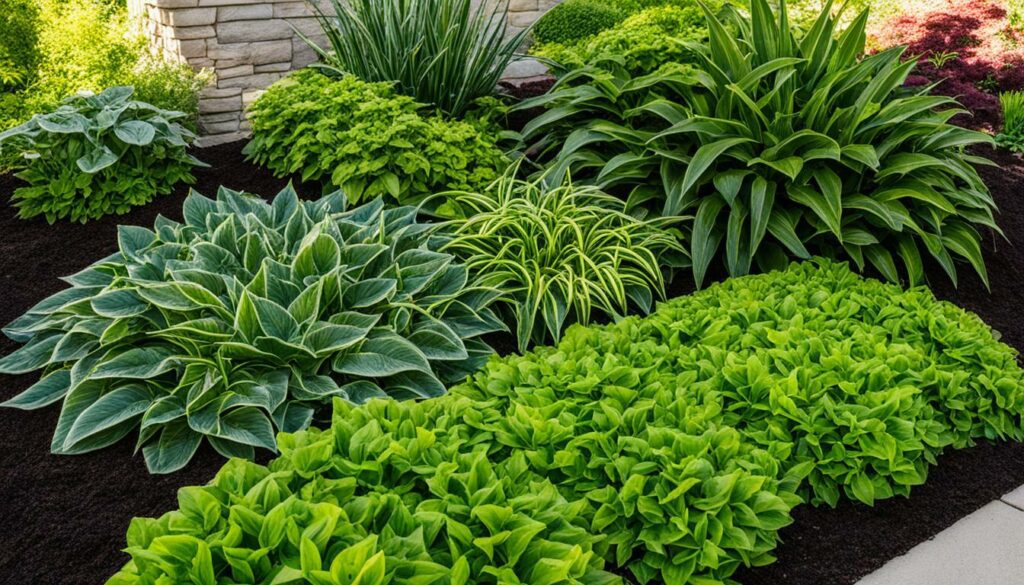
Organic mulch is also brilliant at stopping weeds. It shades the ground and keeps weed seeds from starting. This can drop weed growth by 90%. Without as many weeds, you won’t need as many chemicals or hard work. Plus, some mulches, like pine straw, make it very hard for weeds to pop up.
Using organic mulch is not just good for plants. It keeps the soil safe and helps the whole garden work better. It’s a must for anyone who loves nature and wants their garden to be eco-friendly.
| Benefit | Organic Mulch Impact |
|---|---|
| Soil Health Improvement | Enriches soil with nutrients, increases organic matter content by 1-2% annually |
| Conservation of Moisture | Reduces evaporation by up to 70%, allows better water penetration |
| Weed Suppression | Reduces weed growth by up to 90%, blocks sunlight for weed germination |
Finding the perfect organic mulch is crucial. It’s key to know the types and what they do for your garden. Organic mulches do a lot, like make the soil better and space look nicer.
We can pick from several types of organic mulch, each great for different kinds of gardens. Examples of these include:
Choosing the right mulch involves looking at a few important things:
Thinking about these points helps pick the best mulch. This leads to gardens that are healthier and look after the planet better.
Mulching helps in many ways but needs proper care. The right ground work, layer thickness, and keeping distance from plant stems matter. Doing these things well makes our gardens much better.
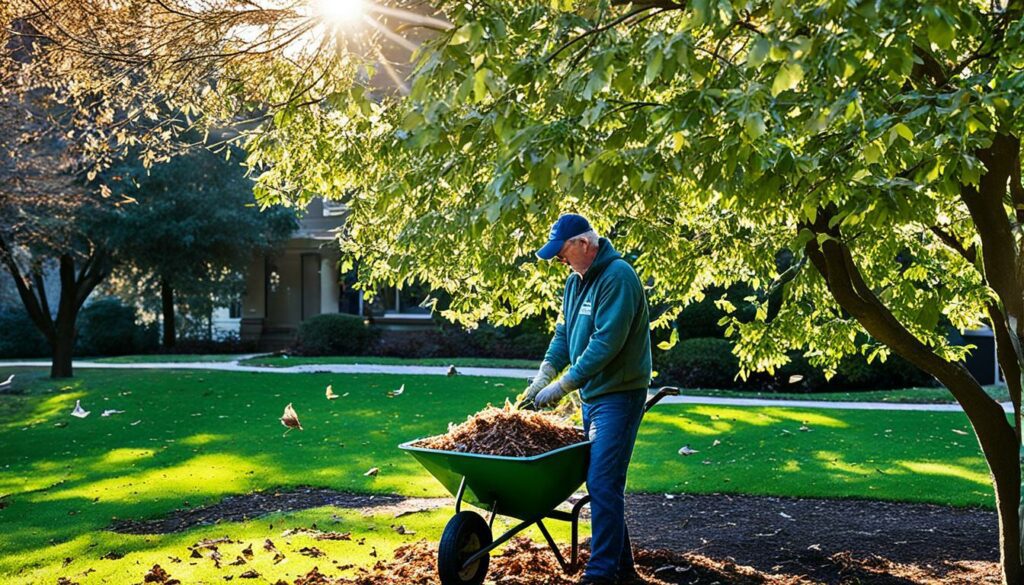
To get the best from mulching, properly prep the soil. First, remove any old plants and clean the area. Then, mix in compost or manure to enrich it. This step helps plants grow strong roots and stay healthy.
The right amount of mulch is key for success. Generally, 2-4 inches is enough, but finer mulches need less than coarser ones. Using the right amount cuts down on weeds, keeps the soil damp, and helps plants.
| Mulch Type | Recommended Thickness | Benefits |
|---|---|---|
| Fine Mulches | 2-3 inches | Efficient weed suppression, moisture retention |
| Coarse Mulches | 3-4 inches | Long-lasting, moderate soil temperature |
| Hay | 3-4 inches | Reduces weed seedling emergence, conserves moisture |
| Grass Clippings | 2-3 inches | Rich in nitrogen, excellent natural fertiliser |
| Shredded Leaves | 3-4 inches | Provides vital nutrients, cost-effective |
Don’t let mulch touch plant stems. Leave a space to avoid problems like rot and pests. For trees, keep a 3-foot gap around them. These steps help plants stay healthy and your garden lively.
Using organic mulch helps our soil stay healthy. We use natural stuff like compost, leaves, and grass clippings. This adds lots of good nutrients back underground. It creates a perfect place for plants to grow strong and fight off tough times.
Organic mulch makes the soil richer. When these natural materials break down, they give the soil important things like nitrogen and potassium. This makes the ground better for plants. It also helps plants stay healthy and strong, even when sick bugs or bad weather come around.
Mulching also gets tiny soil friends working hard for us. The break down of the mulch lets good microbes thrive. These little helpers turn old stuff into food for plants. With more of them working, the soil becomes a healthy place for plants to grow.
Using mulch in the right way makes gardens and farms great places for growth. For more tips on organic mulching benefits, keep learning and staying up to date.
| Type of Mulch | Benefits |
|---|---|
| Bark Mulch | Suitable for plants preferring neutral to alkaline soil; aids in weed control |
| Compost | Enriches soil with nutrients, improves soil structure |
| Grass Clippings | Prevents erosion, aids in water absorption |
| Straw | Insulates soil, stabilises temperatures |
| Leaves | Promotes soil health, suppresses weed growth |
Adding organic mulching sustainable gardening practices to our routines helps the environment thrive. It lessens our need for man-made fertilisers. Yet, it lets gardeners enjoy many perks while keeping their commitment to green values.
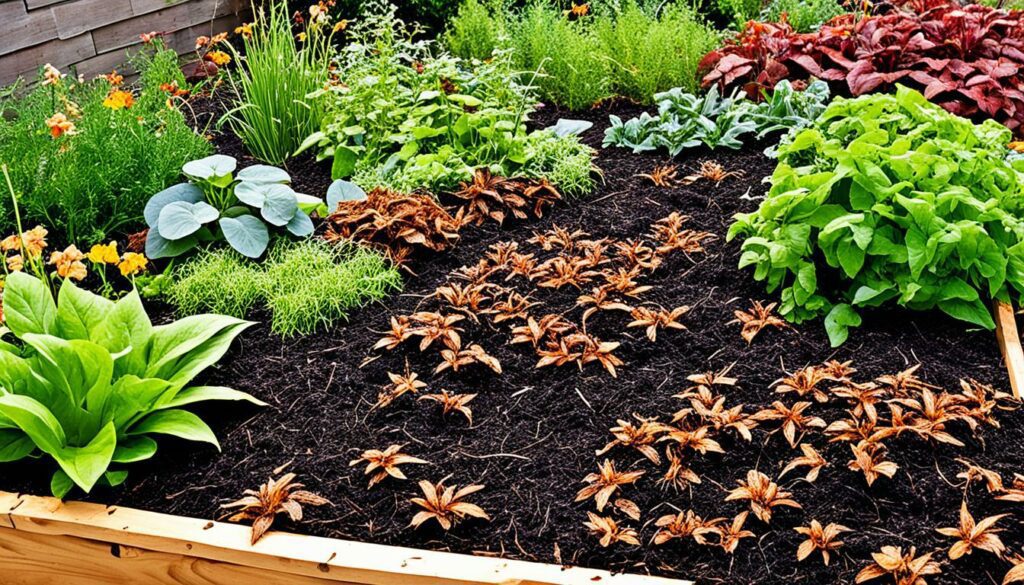
When gardeners lay down around 3-4 inches of hay mulch, they cut down on the number of new weeds. This is especially true for tiny, leafy weeds. Grass hay is better for this than legume hay because it doesn’t have as much nitrogen or phosphorus. It does have more potassium, though. This mix helps soil life, crops, and welcomes good bugs and weed-eating friends.
But, using hay mulch might increase the soil’s potassium too much over time if you’re not careful. Many gardeners balance this by swapping between different types of plants they put down as mulch each year. This smart swap keeps the nutrients in harmony and stops overdoing it.
Think about mulches like wood chips and bark. They break down slowly and make soil hold onto water better. Stuff like Bowcrow Mulch is great at this, which can lower how much water your garden needs. Or, you could try cedar mulch. It stands up to the wind well and can help keep weeds away. This all shows how useful organic mulch is for the planet and your garden.
In short, using organic mulching sustainable gardening techniques does a lot more than make your garden look nice. It’s about taking care of the earth in a smart, eco-friendly way. These efforts help our soil and the whole environment. They make sure there are plenty of plants, animals, and insects for the future.
In the search for eco-friendly landscaping, we find green gardening techniques important. Gardeners now choose organic and sustainable mulches more often. This shows we care about the Earth and its health. It also means we’re moving away from mulches that can be harmful, like those with chemicals.
Gravel and stone mulches work well for plants that like good drainage. They also help keep weeds away. But, organic mulches such as straw, leaves, cocoa shells, and living plants are great for the soil. They keep weeds down too. Using old newspapers as mulch is even better. It stops weeds and is kind to the planet because it uses natural inks.
Building cities and farming have taken away many natural habitats. This has hurt the variety of life on Earth. In the past, city landscapes needed a lot of water and chemicals for plants. Now, using landscaping tools that are less polluting helps the planet. We can also reuse materials from landscaping to make less waste.
Xeriscaping helps save water by using plants that don’t need much of it. Many places in California use this method. It makes gardens pretty and is eco-friendly. Grasscycling is another great idea. It uses grass clippings to save water and feed the soil. Planting native California plants also helps wildlife. It gives them a place to live, even in small gardens.
Using these green gardening techniques makes our gardens look good. They are also better for the planet. By adding organic mulch and other Earth-friendly practices, our gardens are both lovely and safe for nature. This shows the value of choosing natural materials.
Turning garden waste into mulch is a great way to help the planet. Using things like leaves, grass clippings, and small branches makes the soil better. Plus, it cuts down on trash.
Composting changes trash into stuff that helps plants grow. Many places have spots where you can drop off this kind of waste. This makes it simple for everyone to join in. Some towns even gather this waste for making fuel or enriching soil, which supports green gardening.
You can use things like grass clippings and leaves to naturally make soil better. They add important nutrients. Renting a skip bin is a good way to handle a lot of garden waste. This helps the environment too.
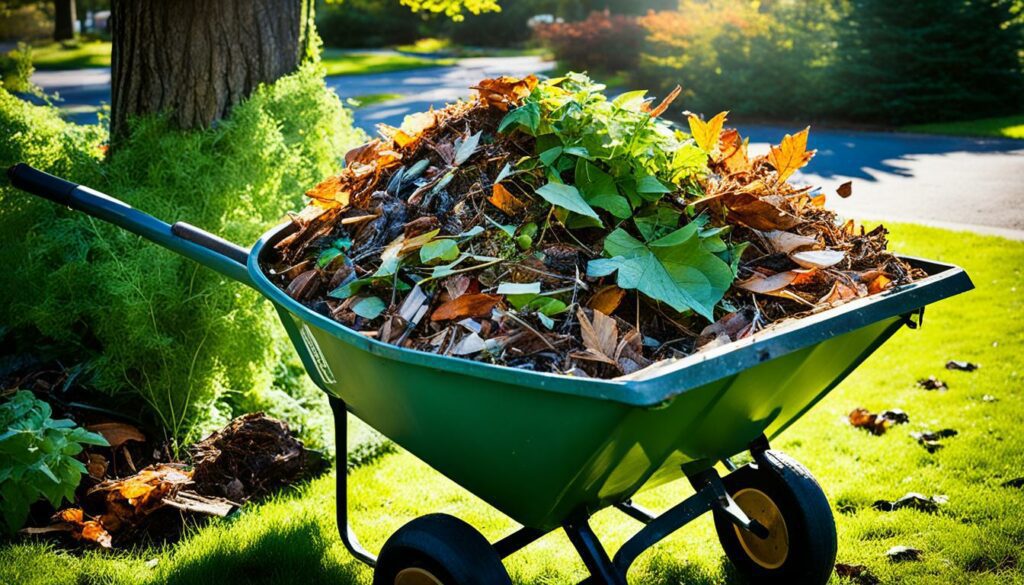
| Type of Waste | Description | Usage |
|---|---|---|
| Green Waste | Fallen leaves, grass clippings, small twigs, branches | Free organic mulch, composting |
| Brown Waste | Bark, fallen branches, woody materials | Garden waste mulch |
For more info on recycling waste, check out this DripWorks Guide on Garden Waste.
Organic mulch is key in eco-friendly gardening, especially for keeping the soil moist. It acts as a barrier, cutting down on water loss through evaporation. This is vital in places where water is scarce.
Organic mulch, like hay, helps keep moisture in the soil. A 3–4 inch layer of hay can stop weed seeds from growing. This reduces the need for plants to fight over water. Grass hay is better at stopping weeds than legume hay, even if it has less nitrogen and phosphorus.
To use mulch well, knowing the risks is crucial. If grass hay has been treated with certain herbicides, it can hurt plants like tomatoes. So, always pick clean hay for healthy plants and to keep moisture in the soil.
Using organic mulch for water retention does more than save water. As the mulch breaks down, it feeds the soil with nutrients, helping plants grow strong. Legume hay is great for providing nutrients. But if you want to keep weeds at bay and hold onto moisture, go for grass hays.
Applying hay mulch by hand works well in small gardens. But in larger areas with plants placed far apart, using big hay rolls is better. These rolls are spread out between the rows to keep the soil moist and support plant growth.
Organic mulch is not just about holding onto water. It enriches the soil and fits perfectly with the goals of sustainable gardening. This creates a garden that’s healthier and stronger.
Using organic mulch right is key to a strong garden. Making sure it’s not too thick helps plants stay healthy. It stops weed growth but still holds water well.
The best mulch depth is between 2 and 4 inches. This is perfect for stopping weeds and keeping in moisture and warmth. Mulches like wood chips break down over time. So, they need topping up to keep that perfect depth.
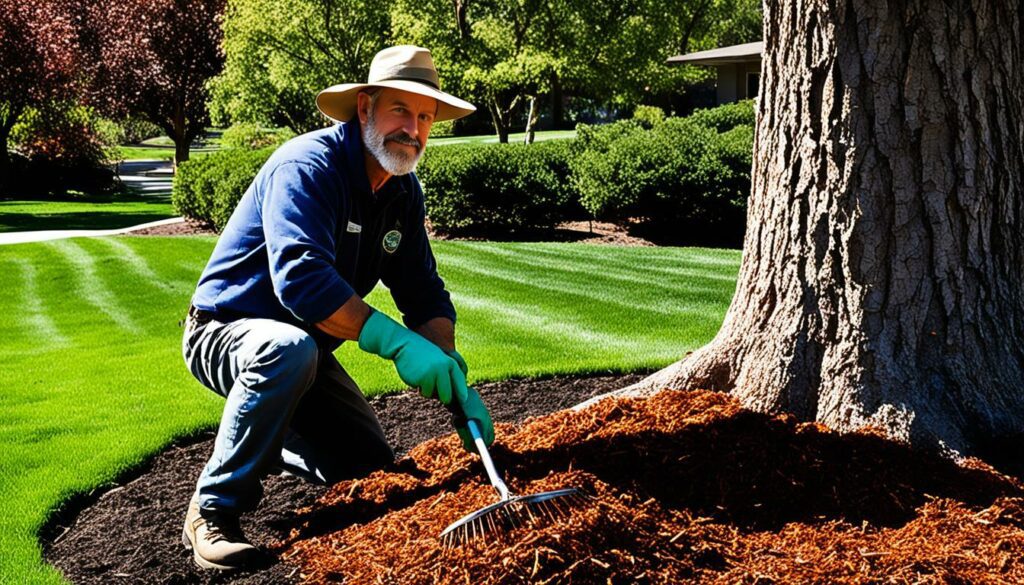
Different mulches need different thicknesses. Fine mulches should be thinner, about 2-3 inches. But, coarse mulch can be thicker, around 4 inches. This way, the soil stays airy and roots get what they need.
Too much mulch can cause issues. The base of plants shouldn’t look like a volcano! It can harm the tree or shrub’s roots and make the trunk too soft. This is why putting just the right amount is so important.
Follow these tips to avoid problems from mulch that’s too deep or too close:
Changing or topping up the mulch every few years is a must. It keeps things looking good and the depth right for plant health.
Over-mulching in gardening is a big issue often missed. It can cause trunk damage, block water and air, and increase root rot risk. Knowing these dangers is crucial for a healthy garden and the best plant growth.
Too much mulch around trees can harm them. It might cause the trunk to rot. For young plants, keep mulch 3 to 5 inches away; for older trees, leave 8 to 12 inches.
Lots of mulch stops water and air from reaching the roots, making them suffocate. Coarse mulches let air through, but finer types should be thinner (1-2 inches) to avoid issues.
Overdoing mulch can lead to root rot. Mulches over 6 inches, especially in wet soils, support fungi and disease. Checking soil pH and changing mulches can prevent this.
| Principle | Recommendation |
|---|---|
| Maximum Mulch Depth | 3 inches (total, including previous mulch) |
| Distance from Trunk | 3-5 inches (young plants); 8-12 inches (mature trees) |
| Poorly Drained Soils | 2 inches maximum depth |
| Coarser Mulches | Can be slightly deeper |
| Fine-Textured Mulches | 1-2 inches layer depth |
| Monitoring Soil | Regular pH testing |
Following these tips helps avoid the problems of over-mulching. It keeps your garden vibrant and well.
Using organic mulch helps not just plants and soil, but also invites good insects and tiny creatures to your garden. More gardeners in the United States are moving towards eco-friendly methods. Around 80% are choosing or looking into organic gardening. They’re finding that natural mulch does a lot of good. It helps earthworms, good bacteria, and fungi thrive.
Earthworms are key in keeping gardens healthy naturally. They make the soil better by their work and what they eat. Items like leaves, compost, and straw in your garden make earthworms very happy. This also helps your soil and plants to be strong.
Aside from insects, organic mulch is great for tiny organisms like bacteria and fungi in the soil. They turn old plant bits into food that plants can use. Some types of mulches, like alfalfa and kura clover, even help fight off plant-eating bugs.
These small organisms also keep the soil just right for plants. They help keep the ground from drying out too much or washing away in the rain. This means a happy garden for all its living parts.
So, using organic mulch is not just a green choice. It also makes your garden a busy and healthy place. As more and more people opt for organic, the garden market is growing fast. By 2025, it could reach $135.3 billion. Organic mulching is key to keeping gardens full of life and balance.
Organic mulching is about using natural stuff like shredded leaves or grass to protect soil. These things break down and make the soil better for plants.
Mulching used to be less green, using things like plastic sheets. Now, using natural materials like leaves is better. It’s all about helping the garden without harming the earth.
There are lots of good things about organic mulching. It keeps the soil healthy, helps with water, stops weeds, and keeps the ground warm. Plus, tiny life forms in the soil (microbes) love it.
It depends on what’s easy to get, the cost, and what your garden needs. Compost, leaves, and cut grass are great options. Make sure it suits your plants and where you live.
First, get the soil ready. Then, put on the mulch just right, not too thick. Finally, spread it evenly without covering plant bases too much.
Organic mulching adds good stuff to the soil and makes it friendlier for tiny life. It’s like feeding the soil so plants can really grow well.
Choosing organic mulch is good for the earth. It means using less harmful chemicals, which helps nature thrive and keeps the garden healthy.
Using organic mulch makes a garden look good and helps the planet. It’s like inviting helpful creatures to live there, creating a happy nature place.
Composting leaves and grass turns waste into something useful. It’s all about making the garden a better place without making more trash.
Mulch stops water in the soil from drying up quickly. This is great for plants in dry places or during times when it doesn’t rain much.
Put about 2 to 4 inches of mulch and spread it well. Watch out for too much mulch around plants. This way, your garden will grow really nicely.
Too much mulch can hurt plants and lead to root rot. It’s important to use mulch carefully to look after your garden.
Organic mulch is like a home for helpful bugs and tiny creatures. They help break down old plants, keep the soil healthy, and feed the garden.